Oxford Airport
Oxford Airport (IATA: OXF, ICAO: EGTK), formerly known as Kidlington Airport, is a privately owned airport located near Kidlington in Cherwell District, Oxfordshire, 6 NM (11 km; 6.9 mi) northwest by north of Oxford,[1] 62 mi (100 km) from Central London.[2] It specialises in general and business aviation and is home to Oxford Aviation Academy, formerly Oxford Aviation Training, the largest air training school in Europe. It is the only ICAO-listed civilian airport in Oxfordshire. Historically dominated by pilot training, in 2008, flying activity fell to just 48,000 movements, the lowest level on record and a 70% decline in 10 years, however, growth in business aviation was the fastest of any UK airport for the years up to 2012.
Oxford Airport Kidlington Airport London Oxford Airport | |||||||||||
|---|---|---|---|---|---|---|---|---|---|---|---|
 | |||||||||||
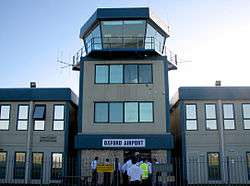 | |||||||||||
| Summary | |||||||||||
| Airport type | Private-owned, Public-use | ||||||||||
| Owner/Operator | Oxford Aviation Services Limited / OxfordJet | ||||||||||
| Serves | Oxford | ||||||||||
| Location | Kidlington, Oxfordshire | ||||||||||
| Elevation AMSL | 270 ft / 82 m | ||||||||||
| Coordinates | 51°50′13″N 001°19′12″W | ||||||||||
| Website | oxfordairport.co.uk | ||||||||||
| Map | |||||||||||
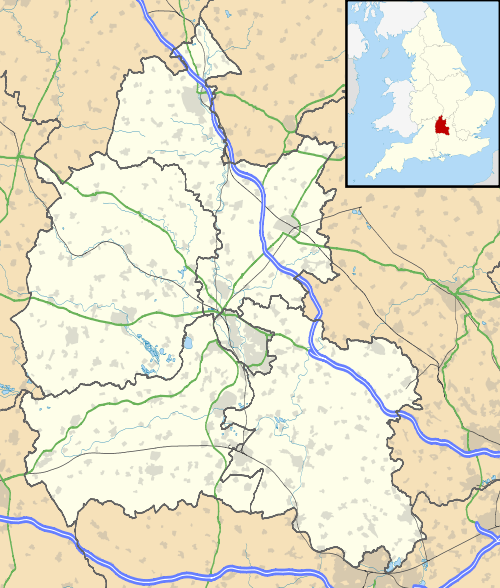 EGTK Location in Oxfordshire | |||||||||||
| Runways | |||||||||||
| |||||||||||
Oxford (Kidlington) Aerodrome is an EASA Certified Airport that allows flights for the public transport of passengers or for flying instruction as authorised by the Certificate Holder (Oxford Aviation Services Limited).
History
The airport was originally established in 1935 by Oxford City Council to act as municipal airport, but following RAF use (as RAF Kidlington) during World War II, it became established as a centre for aviation education, charter and maintenance facilities.
The following units were here at some point:[3]
- No. 1 Air Crew Holding Unit RAF
- No. 3 Maintenance Unit RAF
- No. 4 Glider Training School RAF
- No. 5 Glider Training School RAF
- No. 6 Service Flying Training School RAF
- No. 15 Service Flying Training School RAF
- No. 20 (Pilots) Advanced Flying Unit RAF
- No. 26 Elementary and Reserve Flying Training School RAF
- No. 42 (Maintenance) Group RAF
- No. 52 Squadron RAF
- No. 96 Maintenance Unit RAF
- No. 101 (Glider) Operational Training Unit RAF
- No. 102 (Glider) OTU RAF
- No. 167 Squadron RAF
- No. 239 Squadron RAF
- No. 265 Maintenance Unit RAF
- No. 411 Squadron RAF
- No. 2792 Squadron RAF Regiment
By 1968, it had become the second busiest airfield in the UK, with 223,270 movements – just 10% fewer than Heathrow. For 5 years just after World War II (1951–1956) Kidlington was base of operations for the Oxford Gliding Club. They later moved due to an increase of powered aircraft activity. They relocated to RAF Weston-On-The-Green.[4]
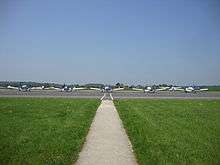
In 1981, the airport freehold was sold by the council and later owned by BBA Aviation plc. In July 2007 the airport was sold for £40m to property entrepreneurs David and Simon Reuben.[5]
A new Saturday-only summer service to Jersey, operated by Air Southwest, ran from July to September 2009.[6] The summer service came back in 2010, operated by CityJet.
In August 2009 the airport was rebranded as London Oxford Airport. The move attracted much press comment,[7][8][9] and criticism from the Oxford Civic Society, which described the new name as misleading;[10] the airport is 60 miles (97 km) from Marble Arch in central London and generally considered to be well outside the London area.[11] However, it was argued that highlighting proximity to London would make the airport more attractive to the overseas business aviation community and now the airport hosts the fourth busiest business aviation handling facility (FBO) in the UK.[11]
In October 2009, London Oxford Airport was approved as a UK entry point for pets, under the Pet Travel Scheme (PETS).[12] It is one of only two UK business aviation centres to offer this service.
Swiss airline Baboo's weekly Saturday service from Oxford to Geneva commenced in December 2009. The service was augmented by a link to Rome through Alitalia Airlines; passengers were thus able to travel from Oxford to Rome, via Geneva.[13]
In January 2010 the airport announced the launch of daily flights to Edinburgh to be operated by new start-up, Varsity Express. However flights were suspended within a week, and the airline ceased operations on 8 March 2010.[14] A spokesman for Oxford Airport later confirmed that talks were under way with other operators, with a view to re-establishing the Oxford-Edinburgh route.[15] It was emphasised that only well-established operators would be invited to service the route.
Plans for a 17,800 m2 (192,000 sq ft) expansion of high-strength apron and a new 4,400 m2 (47,000 sq ft) hangar were outlined at the end of July 2010.[16] The intention was to create capacity for up to 40 medium to large executive jets, in order to cater for major public events such as the Olympic Games.
In January 2012, Manx2 announced the start of a scheduled service from Oxford to the Isle of Man, beginning in May 2012. By 2013, this became a short-term seasonal service focussed around the Isle of Man TT motorcycling event.
From March 2013 to August 2013, Minoan Air flew from Oxford to both Dublin and Edinburgh.
Current
Today, 35% of the airport's activity is accounted for by Oxford Aviation Academy training student commercial pilots under a Civil Aviation Authority/European Aviation Safety Agency (CAA/EASA) licence. 10% is business aviation, both private and charter, and the remaining 55% is mainly private and recreational general aviation activity.
Principal companies based at Oxford Airport include Oxford Aviation Academy, Airways Aviation Academy,[17] Eurocopter (now Airbus Helicopters), Gama Aviation, Volare Aviation, Jet Connections, Excellence Aviation,[18]Flairjet, AirMed, Go Fly Oxford[19] Pilot Flight Training[20] and Capital Air Services.[21] London Executive Aviation based its Embraer Legacy 600 jet at Oxford Airport in 2009,[22] and announced plans to base a Cessna Citation Mustang very light jet (VLJ) at the facility thereafter.[23]
In April 2009, London Oxford Airport was named as one of Europe's top Fixed-Base Operators (FBOs) in Altitudes Magazine, the only UK-based FBO to be listed, and an honour shared by only eight other FBO's across Europe and the Middle East.
In December 2009, London Oxford Airport was voted the 'Best British Business Aviation Airport' at the AOA Annual Awards Ceremony in London.
In April 2019, The Oxford Helicopter started tour operations from Oxford Airport[24]
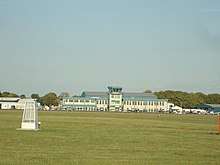
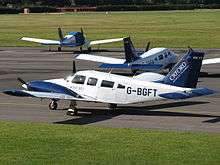
Expansion
The airport continues to consider new scheduled routes, including flights to Amsterdam, Belfast, Edinburgh, Frankfurt, Glasgow, Jersey, Munich and Paris. These markets are said to be the more viable routes for the airport. In December 2015, the UK government confirmed funding support for a proposed reinstatement of the Oxford – Edinburgh route.[25]
However, the primary focus today is the London region business aviation market where the airport is the sixth busiest for this sector in the UK, but hosts the fourth-busiest FBO (Fixed-Base Operation – VIP aircraft handling facility) with over 5,500 business aircraft movements a year. Within the private and business aviation sector, the airport handled over 8,000 private passengers in 2015 whilst such flights were originating from or destined for well over 50 different overseas airports including the US, Canada, African and Middle-Eastern cities.
Technical information

The main runway (Code 3C) is fully grooved and 1,552 m (5,092 ft).[26] In 2007 the airport re-surfaced, strengthened and widened the main runway, taxiways and aprons, and installed new airfield ground lighting and a CAT 1 instrument landing system (ILS). In early 2012, a new state-of-the-art Thales primary and secondary radar system was installed. In 2008 a new £2.5m business aviation terminal was completed (FBO) and is operated by Oxfordjet. The airport can handle aircraft up to and including the Boeing BBJ and Airbus ACJ series. For the business aviation operator, the airport is an approximately 60-minute drive time from the West End area of central London but offers helicopter shuttles in 25 minutes to central London's Battersea Heliport which is co-owned with London Oxford Airport.
Transport
Oxford Airport is served by a seven-day Oxford Airport Shuttle bus service to and from Oxford railway station and Oxford bus station. Other local bus services operated by the Oxford Bus Company and Stagecoach Buses connect the airport to the town. Although Oxford Airport is located approximately 1 kilometre (0.62 mi) from the Cherwell Valley Line, it has no direct rail service. The nearest railway stations are Hanborough, Tackley and Islip.[27]
Accidents and incidents
- In 1941, pioneer aviator Amy Johnson crashed in the Thames Estuary while on a flight en route to Oxford Airport from Blackpool.
- On 6 December 2003, three people were killed at Oxford Airport when a Socata TBM 700 crashed while on approach. The Air Accidents Investigation Branch could find no cause for the crash.[28] There were no technical problems with the plane, and they could only speculate that the pilot of the plane was distracted by a bird as he tried to land. The plane went into an uncontrolled roll, killing Paul-Louis Halley, a French billionaire, his wife and the pilot.
- An Oxford Aviation Training aircraft crashed shortly after takeoff in August 2006.[29] The PA28 Piper Cherokee breached the airport's perimeter fence, and came to a stop upside down on the adjoining public road. Despite significant aircraft damage and fuel leakage, no fire ensued, and no-one was hurt in the incident.
- On 15 January 2010, at about 1400GMT, a Piper PA-31 Navajo crashed by the A4095 (near the airport), killing two people. Four crews from Oxfordshire Fire and Rescue Service, and the South Central Ambulance Service, attended, but the fire was not put out for 1 hour and 40 minutes due to the icy conditions and remote location making laying hoses difficult. The UK's AAIB investigated the accident.[30][31]
See also
- Airports of London
- List of airports in the United Kingdom and the British Crown Dependencies
- List of former Royal Air Force stations
- List of Royal Air Force stations
- Oxford Aviation Academy
- Oxford-Cambridge Arc
- RAF Brize Norton
References
- "Oxford/Kidlington – EGTK". Retrieved 25 February 2018.
- "Charing Cross to Oxford Airport". Google Maps. Retrieved 17 December 2010.
- "Kidlington (Oxford)". Airfields of Britain Conservation Trust. Retrieved 17 May 2020.
- "Airport History". London Oxford Airport. Oxford Aviation Services Ltd. Archived from the original on 28 April 2016. Retrieved 3 November 2015.
- Prosser, David (21 July 2007). "Reubens brothers buy Oxford airport". The Independent. London. Archived from the original on 30 September 2007.
- "Air Southwest to operate Oxford-Jersey flights". Archived from the original on 23 August 2009. Retrieved 25 February 2018.
- The Guardian : 18 August 2009 : New York, Paris...Oxford? Retrieved 20 August 2009
- The Telegraph : 19 August 2009 : London Oxford Airport – a Tale of Two Cities Retrieved 20 August 2009
- The Times : 19 August 2009 : Plane Speaking Retrieved 20 August 2009
- British Broadcasting Corporation : 17 August 2009 : London Airport Name Change Row Retrieved 19 August 2009
- Oxford Mail : Outrage at Airport Rebranding
- Oxford Mail : Airport offers VIP treatment for pets. Retrieved 12 October 2009
- Oxford Mail : Oxford Airport makes Italian connection. Retrieved 10 December 2009
- Oxford Mail:Edinburgh Flights Grounded A Week After Launch Retrieved 11 March 2010
- Oxford Mail : The fall of Varsity Express Retrieved 20 March 2010
- BBC News:London Oxford Airport sets out £2.2m expansion plan Retrieved 2010-30-07
- "Oxford, United Kingdom | Pilot Training Academy".
- "Private Jet Management, Sales & Acquisition – Jet Connections". Jet Connections. Retrieved 25 February 2018.
- "Learn to Fly – Flying Lessons & Pilot Training in Oxford & London". www.goflyoxford.co.uk. Retrieved 25 February 2018.
- "Pilot Flight Training – Flying Lessons – Trial Flying Lesson – Oxford – Oxfordshire- Home – Pilot Flight Training". Pilot Flight Training. Retrieved 25 February 2018.
- "Private helicopter charter and management – Capital Air Services". Capital Air Services. Retrieved 25 February 2018.
- London Oxford Airport: Charter and Air Taxi Archived 19 January 2013 at the Wayback Machine Retrieved 22 January 2013
- London Executive Aviation : LEA Launches Mustang Service at Oxford Retrieved 22 August 2009
- "Helicopter Rides over Oxford & Beyond".
- "London Oxford Airport (OXF) – Unserved Routes in the Route Shop". www.therouteshop.com. Retrieved 25 February 2018.
- Oxford Airport: General Airport Info Archived 12 August 2011 at the Wayback Machine Retrieved 13 May 2011
- "Transport links to Oxford Airport". London Oxford Airport. Archived from the original on 26 October 2016. Retrieved 25 October 2016.
- AAIB Bulletin No: 5/2005. Ref EW/C2003/12/03 (PDF)
- AAIB Bulletin No: 2/2007, G-BYKR. Ref EW/C2006/08/06 (PDF) Retrieved 17 October 2009
- "Two people killed in plane crash". BBC News. 15 January 2010.
- "Piper PA-31P Pressurised Navajo, N95RS" (PDF). AAIB. November 2010. Retrieved 7 September 2014.